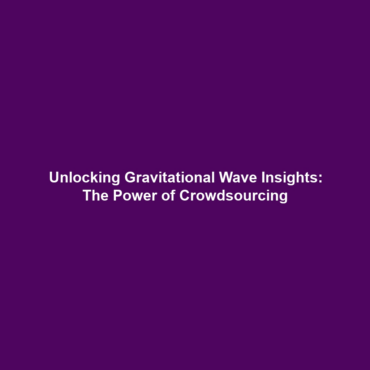Crowdsourcing: A Key to Unlocking Gravitational Wave Data
Introduction: The study of gravitational waves has revolutionized our understanding of the universe, revealing the intricacies of cosmic events that produce these ripples in spacetime. As research advances, the challenge lies in analyzing vast amounts of data generated from gravitational wave observations. Crowdsourcing emerges as a powerful tool, enabling scientists and amateur enthusiasts alike to sift through this data more efficiently. This article delves into how crowdsourcing can assist in this critical endeavor, highlighting its significance within the fascinating context of gravitational waves.
Key Concepts in Crowdsourcing Gravitational Wave Data
Crowdsourcing refers to the practice of obtaining input or data from a large group of people, typically via the internet. In the realm of gravitational waves, this concept allows a diverse array of contributors to participate in data analysis, enhancing research efforts. Major principles of this approach include:
- Collaborative Analysis: Coordinating varied inputs from multiple participants increases the likelihood of identifying significant events in the data.
- Accessibility: Crowdsourcing democratizes data analysis, enabling non-experts to assist in scientific research.
- Data Diversity: Utilizing a larger pool of contributors can lead to diverse perspectives and innovative methods in data interpretation.
Applications and Real-World Uses
The applications of crowdsourcing in gravitational wave data analysis are noteworthy. Some practical uses include:
- Citizen Science Projects: Platforms like Zooniverse allow individuals to analyze gravitational wave data alongside professional astronomers.
- Anomaly Detection: Crowdsourced data analysis can help identify unusual signals in gravitational waves, enhancing event detection.
- Educational Outreach: Crowdsourcing serves to engage the public in science, making gravitational wave research more accessible and inspiring future generations of scientists.
Current Challenges in Crowdsourcing Gravitational Wave Data
Despite its advantages, several challenges hinder the effective implementation of crowdsourcing in gravitational wave research. These include:
- Data Quality Control: Ensuring that the contributions from various volunteers meet scientific standards can be complex.
- Participant Training: A lack of expertise among participants may lead to misinterpretation of data.
- Data Volume: The sheer amount of data generated can overwhelm contributors, making it challenging to find salient information.
Future Research and Innovations
The future of crowdsourcing in gravitational wave data analysis looks promising. Upcoming innovations may include:
- AI and Machine Learning Integration: Leveraging algorithms to assist crowdsourced efforts, enhancing speed and accuracy in identifying significant events.
- Improved Platforms: Development of more user-friendly interfaces that make participation easier for non-experts.
- Enhanced Collaboration Tools: Creating better communication channels among participants to facilitate discussion and learning.
Conclusion
In conclusion, crowdsourcing presents a valuable approach to sifting through gravitational wave data, allowing researchers to tap into a collective effort that can enhance scientific discovery. As we look to the future, the combination of crowdsourcing, advanced technologies, and collaborative platforms promises to redefine how we analyze and understand gravitational waves.
For further reading on related topics, please explore our articles on Gravitational Waves and Data Science in Astronomy.

